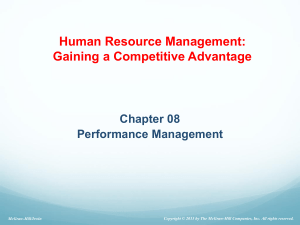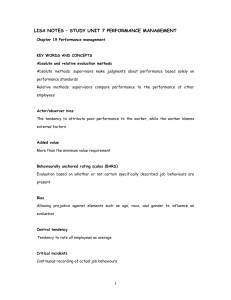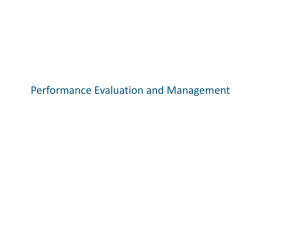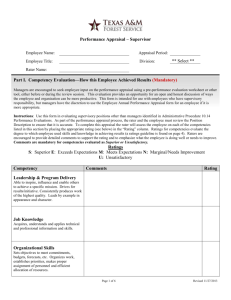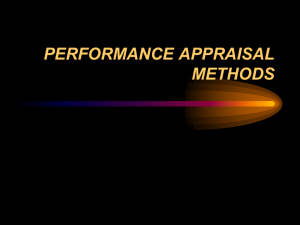Industrial Psychology
advertisement
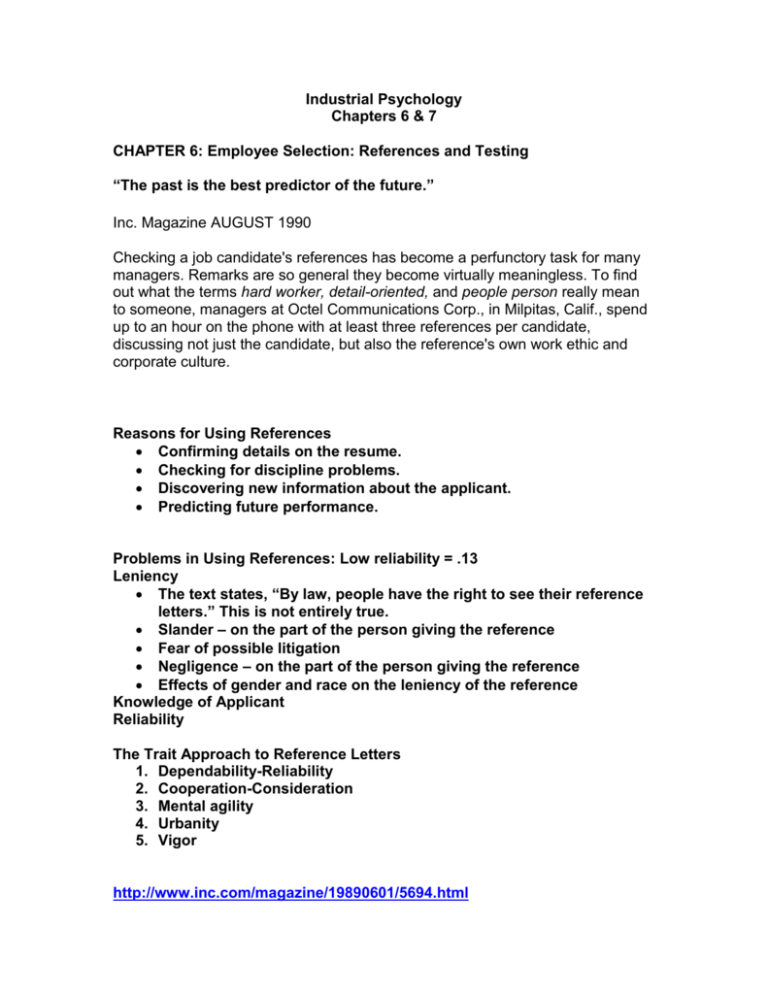
Industrial Psychology Chapters 6 & 7 CHAPTER 6: Employee Selection: References and Testing “The past is the best predictor of the future.” Inc. Magazine AUGUST 1990 Checking a job candidate's references has become a perfunctory task for many managers. Remarks are so general they become virtually meaningless. To find out what the terms hard worker, detail-oriented, and people person really mean to someone, managers at Octel Communications Corp., in Milpitas, Calif., spend up to an hour on the phone with at least three references per candidate, discussing not just the candidate, but also the reference's own work ethic and corporate culture. Reasons for Using References Confirming details on the resume. Checking for discipline problems. Discovering new information about the applicant. Predicting future performance. Problems in Using References: Low reliability = .13 Leniency The text states, “By law, people have the right to see their reference letters.” This is not entirely true. Slander – on the part of the person giving the reference Fear of possible litigation Negligence – on the part of the person giving the reference Effects of gender and race on the leniency of the reference Knowledge of Applicant Reliability The Trait Approach to Reference Letters 1. Dependability-Reliability 2. Cooperation-Consideration 3. Mental agility 4. Urbanity 5. Vigor http://www.inc.com/magazine/19890601/5694.html Psychological Testing Reliability and Validity Cost and Error of Use Potential Legal Problems Scoring Methods Objective Subjective Personality Test Rorschach Inkblot: http://www.psychologicalscience.org/pdfreq.cfm?PATH_INFO=/news research/publications/journals/sa1_2.pdf&VARACTION=GO&CFID=13 70845&CFTOKEN=19911862 TAT MMPI Holland’s Vocational Counseling Test General Aptitude Battery Test (GATB) ASVAB http://www.todaysmilitary.com/explore_asvab.shtml Wonderlic Personnel Test http://www.wonderlic.com/default1.asp Perceptual Ability Psychomotor Ability Job Knowledge Test Integrity Test (honesty test) Voice Stress Analyzer http://trusters.com/portable_lie_detector.html Polygraph Physical Agility Test Job relatedness Passing scores When the ability must be present Biodata Assessment Centers In Basket Techniques Simulations Work Samples Games Drug Testing Handwriting Analysis CHAPTER 7: Evaluating Employee Performance WHY PERFORMANCE APPRAISALS? They are frustrating They are motivating It is or should be part of the integrated whole performance structure of the organization 1. Compensation 2. Promotion 3. Discipline 4. Termination 5. Selection of New Employees 6. Training/Development 7. Strategy The Case For Performance Appraisals Spots performance problems and create a paper trail - weed employees out or help to develop Merit pay Can help identify latent leadership traits PA's can serve as a crystal ball - looking into the future/history of the organization Involve the employee - information on goals, mission, expectations Communication Channel - Feedback The Case Against Performance Appraisals Edwards Deming, noted the devastating effects performance appraisals have had on performance and why performance reviews and merit ratings should be eliminated. In his book Out of the Crisis, he writes that the performance appraisal "nourishes short-term performance, annihilates long-term planning, builds fear. demolishes teamwork, and nourishes rivalry and politics." Too much work Only used as a justification for tough choices Doesn't necessarily mean more money Distinction between "fired" and "laid off" Turnover is high - PA's are not done regularly enough to provide a record Employees care less about performance appraisals than they used to PERFORMANCE EVALUATION AND THE LAW The Equal Employment Opportunity Commission is responsible for administering and enforcing the Civil Rights Act of 1964. The EEOC issued the Uniform Guidelines on Employment Selection Procedures in 1978, and these were intended to be applied to all human resource decisions. As such, these guidelines definitely have an effect on performance evaluation although the legal requirements for an appraisal system are less clearly defined by the guidelines; the guidelines focus heavily on validating selection procedures. Thus, it is actually more difficult to determine what makes a performance evaluation system legal. A number of court rulings have focused on the responsibilities of management in developing and using a performance evaluation system in a legally defensible way. One of the most important early cases was Brito v. Zia Company (1973) in which the company was found to be in violation of the law. The court ruled that the company had not shown that its performance evaluation instrument was valid in the sense that it was related to important elements of work behavior in the jobs for which the employees were being evaluated. WHO SHOULD JUDGE PERFORMANCE The operating manager (the immediate supervisor) does the evaluation in a vast majority of cases. There are, however, other possibilities as well. Many corporations will use other raters to supplement the evaluations of the immediate supervisor: Rating by a Committee of Several Superiors The supervisors chosen are those most likely to come in contact with the employee. This approach has the advantages of offsetting bias on the part of one superior and adding additional information to the evaluation, especially if it follows a group meeting format. Rating by the Employee's Peers (Co-Workers) In the peer evaluation system, the co-workers must know the level of performance of the employee being evaluated. For this system to work, it is preferable for the evaluating peers to trust one another and not be competitive for raises and promotions. This approach may be useful when the tasks of the work unit require frequent working contact among peers. Rating by the Employee's Subordinates. It is used more for the developmental aspects of performance evaluation than are some of the other methods. Managers are less likely to accept being rated by subordinates if the information is going to be used for administrative purposes (for example, raises, promotions) than if it is used for development. This source of rating information is also more acceptable if the managers believe that the raters (subordinates) are familiar with the job. Also, subordinates' evaluations should probably be restricted to "people-oriented" issues such as leadership and delegation, rather than having them evaluate organizing, planning, and other less easily observed aspects of the manager's performance. Rating by Someone outside the Immediate Work Situation Known as the field review technique, this method uses a specialized appraiser from outside the job setting, such as a human resource specialist, to rate the employee. This approach is often costly, so it is generally used only for exceptionally important jobs. It might be used for the entire work force if accusations of prejudice must be countered. A crucial consideration is that the outside evaluator is not likely to have as much data as evaluators in any of the other four approaches, and the use of an outside evaluator represents a somewhat atypical approach to appraising performance. Self-Evaluation In this case, the employee evaluates herself or himself with the techniques used by other evaluators. This approach seems to be used more often for the developmental (as opposed to evaluative) aspects of performance evaluation. It is also used to evaluate an employee who works in physical isolation. Rating by a Combination of Approaches Finally, a combination of approaches can be used (360 degree). For example, supervisors' ratings can be supplemented with self-evaluations or peer evaluations. Using self and supervisor ratings together allows for meaningful discussions of past performance and areas in which improvement is needed. This kind of open, two-way communication forms the foundation for the effective use of performance evaluations as a major source of employee feedback. WHAT PERFORMANCE TO MEASURE A study found that, for white-collar workers, performance factors such as the following were used by these percentages of organizations surveyed: quality of work 93 percent quantity of work 90 percent job knowledge 85 percent attendance 79 percent Personality factors used were: initiative 87 percent cooperation 87 percent dependability 86 percent need for supervision 67 percent COMPARING PERFORMANCE TO ESTABLISHED STANDARDS 1) Observation 2) Checklists and Weighted Checklists Another type of individual evaluation method is the checklist. In its simplest form, the checklist is a set of objectives or descriptive statements. If the rater believes that the employee possesses a trait listed, the rarer checks the item; if not, the rater leaves it blank. A rating score from the checklist equals the number of checks. 3) Graphic Rating Scale There are several individual evaluation methods used in business today but the oldest and perhaps the most common one is the graphic rating scale. Using this technique, the rater is presented with a set of traits and asked to rate employees on each of the characteristics listed. The number of characteristics rated varies from a few to several dozen. 4) Critical Incident Technique Simply stated, this technique requires raters to maintain a log of behavioral incidents that represent either effective or ineffective performance for each employee being rated. These incidents are critical incidents. Because these incidents might not be directly comparable for different ratees, lists of standardized incidents can be prepared by the HR specialist in consultation with the operating managers. Then, the rating task becomes one of logging each time a subordinate engages in one of these behaviors. 5) Behaviorally Anchored Rating Scales Smith and Kendall developed what is referred to as the behaviorally anchored rating scale (BARS) or the behavioral expectation scale (BES). The BARS approach relies on the use of critical incidents to serve as anchor statements on a scale. A BARS rating form usually contains 6 to 10 specifically defined performance dimensions, each with 5 or 6 critical incident anchors. A BARS usually contains the following features: 1. Six to 10 performance dimensions are identified and defined by raters and ratees (a group is selected to construct the form). 2. The dimensions are anchored with positive and negative critical incidents. 3. Each ratee is then rated on the dimensions. 4. Ratings are fed back using the terms displayed on the form. 6) Essay Evaluation In the essay technique of evaluation, the rater is asked to describe the strong and weak aspects of the employee's behavior. COMPARISON BETWEEN INDIVIDUALS By design, the methods of performance evaluation described so far are supposed to be used for evaluating employees one at a time with no direct comparisons for an employee with another. In this section, three techniques that compare one employee's performance to that of one or more others will be discussed. Ranking In their simplest form, rankings ask a supervisor to generate a list of subordinates in order on some overall criterion. This can be very difficult to do if the supervisor is asked to rank a large number of subordinates, for example, over 20. Paired Comparison First, the names of the persons to be evaluated are placed on separate sheets (or cards) in a predetermined order, so that each person is paired with all others to be evaluated. The evaluator then checks the person that is the better performer within each set of two-person pairs. Forced Distribution The forced-distribution system is similar to grading on a curve. The rater is asked to rate employees in some fixed distribution of categories, such as 10 percent in low, 20 percent in low average, 40 percent in average, 20 percent in high average, and 10 percent in high. Which Technique to Use Which technique should be used in a specific instance? The literature on the shortcomings, strengths, reliabilities, and validities of each of the techniques is vast. In essence, there are studies showing that each of the techniques is sometimes good, sometimes poor. The major problems are not with the techniques themselves, but how they are used and by whom. Untrained raters or those that have little talent or motivation to evaluate well can destroy or hamper any evaluation technique. The rater is more critical than the technique in developing effective evaluation systems. Evaluation techniques can be judged on a series of criteria, such as costs and purposes. As noted in the discussion of the approaches to evaluation above, at least two major purposes are served by evaluation: counseling and personal development, and evaluation for rewards, such as an aid in promotion decisions. Some evaluation techniques serve one purpose better than others. Some systems cost more to develop and operate than others. POTENTIAL PROBLEMS WHEN CONDUCTING PERFORMANCE EVALUATIONS Regardless of which technique or system is chosen, there are going to be many problems encountered trying to use it. None of the techniques is perfect; they all have limitations. Some of these limitations are common to all of the techniques, while others are more frequently encountered with certain ones. System Design and Operating Problems Rater Problems Leniency or harshness. Central/tendency error. Recency of events error. Contrast effects. Personal bias (stereotyping; similar to me). Employee Problems with Performance Evaluation For the evaluation system to work well, the employees must understand it and feel that it is a fair way to evaluate performance. In addition, they must believe that the system is used correctly when making decisions concerning pay increases and promotions. Thus, for a performance evaluation system to work well, it should be as simple as possible unnecessary complexity in rating forms or other evaluation procedures can lead to employee dissatisfaction. The system should also be implemented in a way that fully informs employees about how it is going to be used. The Feedback Interview Suggestions for Effective Evaluation Interviews: Steps and Skills 1. Raters and ratees should prepare for the meeting and be ready to discuss the employees's past performance against the objectives for the period. 2. The rater should put the employee at ease and stress that the interview is not a disciplinary session, but a time to review past work in order to improve the employee's future performance, satisfaction, and personal development. 3. The rater should budget the time so that the employee has approximately half the time to discuss the evaluation and his or her future behavior. 4. The rater should use facts, not opinions. Evidence must be available to document the claims and counterclaims. 5. The rater should structure the interview as follows: First, open with specific positive remarks. Second, sandwich performance shortcomings between two positive result discussions. Third, conclude with positive comments and overall evaluation results. 6. The rater should guard against overwhelming the ratee with information. Too much information can be confusing, while too little information can be frustrating. The rater must balance the amount of information that is provided. 7. The rater should encourage ratee involvement and self-review and evaluation. Ask the ratee to do his or her own evaluation on a periodic basis. 8. The final aspect of the interview should focus on future objectives and how the superior can help the employee achieve enterprise and personal goals. Properly done, the interviews contribute importantly to the purposes of performance evaluation.



